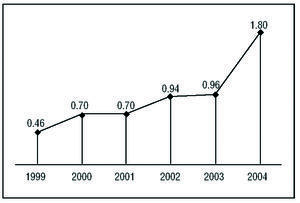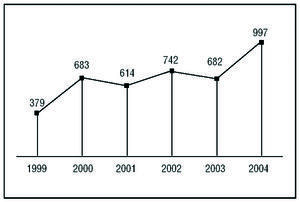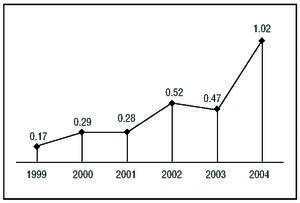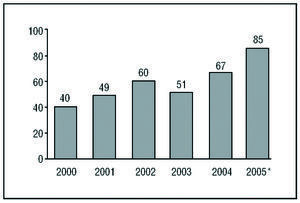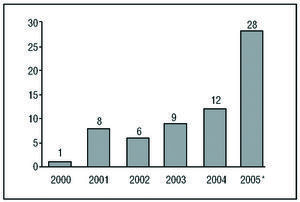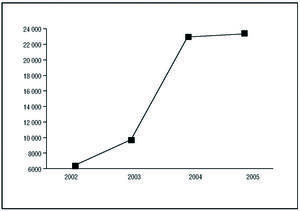Each year the Editor's Page in the December issue of Revista Española de Cardiología summarizes the highlights regarding the activities, dissemination and scientific repercussion of our journal.1,2 This gives our readers an idea of the work undertaken during the year, explains new aspects of our editorial policies, and reports on the journal's position in terms of its scientific impact.1-5 As a hint to what is in store for readers below, we would like to anticipate that from this standpoint that the journal deserves to be congratulated on its achievements.
Some of the topics discussed here were reported to the Board of Directors of the Spanish Society of Cardiology (SEC) and during the General Assembly at the Congress on Cardiovascular Diseases held recently in Barcelona. This information was also communicated in detail at the annual Editorial Board meeting, which generated some interesting discussions on the goals we should aim for in the future.
SCIENTIFIC IMPACT
This year Revista Española de Cardiología has reached a milestone in terms of bibliometric performance6,7: our impact factor has doubled with respect to last yearan unprecedented improvement6 (Figure 1). The increase in this popular indicator consolidates our publication's preeminent position among medical journals published in Spanish. Moreover, we are now ranked 28th in the select club of 71 cardiovascular journals indexed by the Institute for Scientific Information.6 The total number of citations received by the journal has also shown a clear increase (Figure 2). An improvement that is all the more notable since it has come about during a period when notably, this was achieved with a stable self-citation rate. Our immediacy index has shown a spectacular improvement, a result that confirms the currency of the journal's coverage of the discipline and places us in a privileged position6 (Figure 3).
Figure 1. Time trend in the impact factor of Revista Española de Cardiología.
Figure. 2. Time trend in the number of citations received.
Figure 3. Time trend in the immediacy index of Revista Española de Cardiología.
A recent Editor's Page essay analyzed in detail the importance and implications of these improvements in our bibliometric indicators.7 On this occasion, then, we simply wish to congratulate and express our appreciation to our authors and reviewers for their efforts, without which it would not have been possible to attain the status we currently enjoy. This position is the fruit of concerted efforts, ambitious and carefully designed editorial strategies,1-3 and of the unconditional support of the SEC in its entirety. For us as editors it is deeply satisfying to offer researchers working in cardiovascular diseases such an attractive bibliometric profile. We would also like to remind readers of the importance of actively citing recent articles in Revista Española de Cardiología in subsequent research articles published in our journal or--a key consideration--in other international journals. The level of quality we have attained means that we can cite articles published in the journal with pride whenever it is scientifically appropriate to do so. This will stimulate the dissemination of our contents, maintain and perhaps further improve our bibliometric indicators, and complete the "circle of prestige" by attracting articles of higher quality to our pages.7
ARTICLES RECEIVED, REVIEW PROCESS, AND TIME TO PUBLICATION
In 2005 we received a total of 454 articles for review. This number is similar to the number of submittals received last year and confirms that our publication is an attractive medium for researchers. The number of manuscripts from countries other than Spain has increased to a total of 85 (Figure 4), including a substantial number of submittals from Cuba (18%), Argentina (9%), and Mexico (9%). Another noteworthy development is the rise in the number of manuscripts being submitted in English (Figure 5). The exponential increase in this number means that we now need to adapt to this new situation, in which our journal has become a consolidated international scientific publication. We therefore need to acquire the capability to review increasing numbers of manuscripts in English, and we also need to guarantee prompt translation into Spanish for those submittals that are accepted.
Figure 4. Time trend in the number of manuscript submittals from other countries. *Data for the last 3 months of 2005 are estimates.
Figure 5. Time trend in the number of manuscripts submitted in English. *Data for the last 3 months of 2005 are estimates.
We are satisfied with the turnaround times our reviewers have been achieving (a median of 20 days to receipt of the first round of reviews), although we will continue to insist on the importance of reducing this time further. Two independent reviewers and a member of our team of methodological and statistical experts evaluate the manuscripts. Thus, we should express our appreciation to all members of the editorial board for their invaluable aid, and our special thanks to all external reviewers who have advised us on the suitability of the manuscripts we have received (Table 1). Their reviews facilitate the difficult process of selecting which papers will be published, and also help enhance the scientific quality of the manuscripts that are eventually accepted. We editors, however, must ensure that the increasingly detailed and critical reviews we receive do not lead to lengthy exchanges with the authors that might needlessly prolong the time taken to reach our final decision.
During 2005 mean time from manuscript reception to publication was 10.3 months for original articles. By way of comparison, our estimates based on data for the first semester of 2005 show that this period is still slightly longer than the time to publication in other cardiovascular journals such as the European Heart Journal (9.2 months), Circulation (8.8 months), and the Journal of the American College of Cardiology (7.4 months). Nonetheless, is should be recalled that these journals use electronic manuscript management systems that have yet to be implemented by our journal.
PRIZES AND SUPPLEMENTS
The year 2005 saw an increase in the number of prizes awarded for the best articles in Revista Española de Cardiología (Table 2). In addition to the prizes awarded by the journal to articles with the greatest international impact, a number of scientific working groups within the SEC award prizes in pertinent areas. This year 19 prizes worth a total of 59 793 euros were awarded in 9 different categories.
During 2005 we published 9 supplements, which is twice the number published as recently as 4 years ago (4 supplements in 2001). The number of articles appearing in supplements has increased substantially to 59 this year, up from 23 articles in 2001.
DISSEMINATION
Currently our 2 electronic editions (in Spanish and English) constitute the journal's most effective tool for dissemination. Especially noteworthy is the number of visits to the online English edition on our website (www.revespcardiol.org) (Figure 6). Likewise, the number of full article downloads in PDF format has increased significantly. In 2005 a total of 13 177 articles in English were downloaded, compared to 8900 in 2004 and 4100 in 2003.
Figure 6. Time trend in visits to our website in English.
This year we have tried to shorten the time to publication of the full English text online. Translation and editing are necessarily rigorous, labor-intensive processes; nonetheless, our goal has been to make the English online version of articles available not longer than 2 months after publication of the original Spanish-language edition.
EDITORIAL POLICIES
In the last 2 years we have adapted our policies to new international requirements for editorial quality.4,5 In this connection we remind authors that manuscripts submitted to Revista Española de Cardiología must now be accompanied by a signed declaration of potential conflict of interest. Moreover, we are cognizant of the problems created by redundant publication, particularly now that all of our articles are translated into English and can be accessed freely via a number of major international databases. Thus, if authors are in any doubt regarding the possibility of duplicate publication (even if duplication is only partial), the solution is clear: any duplication should be communicated frankly to the editorial board.8
The rapid translation and publication in our journal of the European Society of Cardiology (ESC) Clinical Practice Guidelines9 has been a considerable editorial challenge which we feel we have met satisfactorily. To date we have published a total of 10 such documents. When it has been possible to arrange early translation with the ESC, mean time to publication has been 2.5 months after initial publication in the European Heart Journal. As a result of our pioneering initiative in this field, translation will soon be initiated at other national journals of the ESC.
This year Revista Española de Cardiología participated for the first time in the official meeting of the HEART (Heart Editors Action Round Table) group, and in a meeting of cardiology journals organized by the ESC. We trust that involvement in these emerging forums for editors will help us to further enhance our publication's international dissemination and prestige.
Correspondence:
Revista Española de Cardiología. Sociedad Española de Cardiología.
Nuestra Señora de Guadalupe, 5-7. 28028 Madrid. España.
E-mail: rec@revespcardiol.org
